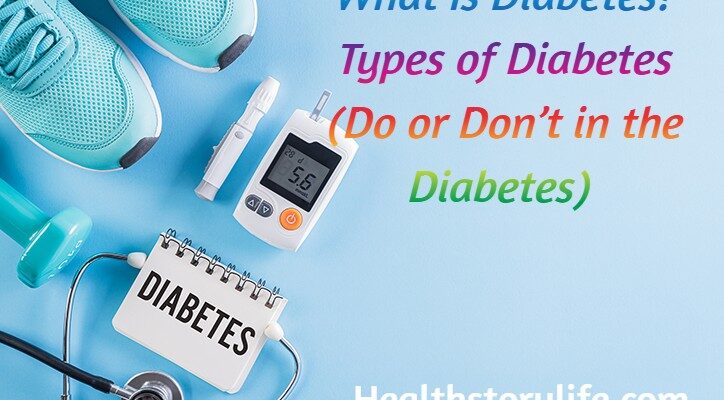What is diabetes
Diabetes is a chronic health problem that affects individuals’ energy production from food. The body usually breaks all the food that we consume into sugar or glucose and releases the energy into the bloodstream (systemic circulation). When the amount of blood sugar increases, the body releases insulin from the pancreas. Insulin is a hormone that acts as the key for cells to use blood sugar as energy.
With a condition like diabetes, the body doesn’t produce enough amount of insulin for proper utilization of blood sugar. When there is no more insulin for a sufficient duration then the cell stats do not respond to insulin. Furthermore, after a sustainable period, it can be a major health cause of problems such as heart disease, vision loss and kidney disease.
There is no cure for diabetes but you can modify your diet and exercise as well as lifestyle to improve the condition and deacceleration of the cell. In this review article, we will discuss diabetes mellitus and things to do and don’t do in this condition.
Types of Diabetes
There are three different types of diabetes and all information regarding the information related to the product.
- Type 1 diabetes
Type 1 diabetes is usually caused due to autoimmune reaction (the body acts against itself). This reaction stops the human body from producing the required insulin. Almost 5 TO 10% of the population suffer from type 1 diabetes all over the globe. Currently, no one has a clue how to control type 1 diabetes.
- Types 2 Diabetes
In this type of diabetes, the body produces insulin but the body doesn’t use the insulin. 90 out of 100 individuals with diabetes suffer from type 2 diabetes. It develops over many years due to bad eating habits and lifestyle. Although the type of diabetes can be delayed and prevented by various methods mentioned below.
- Losing excessive weight
- Consumption of healthy food
- active lifestyle with the help of exercise
- Gestational Diabetes
It develops during pregnancy and can happen to women with no diabetic record. It can cause higher risk problems for infants or babies. It mostly goes away after the delivery of the child. Moreover, it can cause risk in later life of type 2 diabetes in the mother and children.
Prediabetes
In the USA, 96 million American adults suffer from prediabetes and more than 80% don’t even know that they have this condition. In prediabetes, blood in the systemic circulation is higher than normal but not high as in type 2 Diabetes. A healthy lifestyle can solve this problem and treat the shootout cause.
Things that can help in diabetes control and prevention (Do or Don’t in the Diabetes)
Diabetes is impacted by everything we do from what we are eating and how much time we are sleeping. Therefore, it Is essential to focus on every minor detail and aspect that can affect diabetes and health.
DO
Exercise:- it can help an individual to maintain a healthy weight and reduction of the risk of diabetes as well as help in keeping the diabetes level under control. The CDC (Centre For Disease Control and Prevention) recommends at least 30 minutes of exercise 5 days a week for risk-free life.
You can select any physical activity that you like based on your preference and try to do that exercise for moderate intensity.
Stop Smoking:- quitting smoking can help an individual to perform better in their physical aspect of health. Stop smoking is one the best thing individual can do and it will help to prevent the risk of developing heart disease and stroke as well as increase the life expectancy of the individual. If you smoke, consider consulting with a doctor before the plan of quitting.
Flu Shot:– an individual with diabetes-like conditions are more prone to hospitalization than other individuals and many of them die from flu than diabetes. Symptoms of diabetes can increase the chance of an individual suffering from influenza and its effect. That is the reason getting the flu shot is the best way to prevent yourself from disease.
Consume medication regularly and check the blood sugar level:- In almost 50% of United State citizens with diabetes consume medication to help themselves. Several individuals suffer from a lack of knowledge regarding the diabetes and medicine they have taken. To control and check the level of blood sugar is essential and can be maintained with continuous exercise as well as diet.
Sleep enough:- sleep is essential for good health and if you don’t get enough sleep, you will get feelings of tiredness, and hungriness and eat more like situations happen. Individuals with less sleep are more likely to get problems with their bad eating problems. Uncontrolled blood sugar can cause insomnia and other sleep disorder.
Don’t
Sugary beverages:- sugar products can affect the level of sugar blood in systemic circulation. This beverage can contain more than 40 grams of sugar in each serving of the product. It can cause individuals to be overweight and artificial sweeteners in the beverage can affect an individual’s health in the wrong way.
Pasta and other carbs:- if you guys consume more than the required amount of carbs, then avoid the use of these types of foods. Not only carbs can make you hungry and they also will not be able to provide you nutrition essential for a balanced lifestyle. Carbs can also generate more amount of blood sugar than other sources of energy such as fat.
Skip meals:– skipping meals can cause lower blood levels or hypoglycemia if you are consuming certain types of diabetes mellitus. Individuals with diabetes should eat three meals every day for better control over sugar concertation.
Conclusion
Diabetes is a major health problem for all of us and we need to take care of yourselves to prevent any discomfort that can occur due to diabetes. A healthy lifestyle including a good diet and exercise is essential for the development and balanced life of the individual. To read more about this topic several websites that are developed to help individuals suffering from this kind of disease and disorder (CDC).


